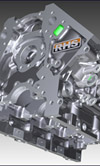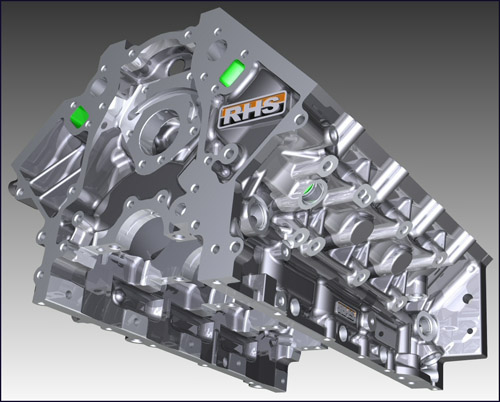A 501 Cubic Inch Aluminium Small Block V8?
 The GM Gen-4 Small Block pushrod V8 engine family (aka LS-X) is growing in popularity and in application as a racing engine as well as a high performance powerplant for roadgoing cars. The basic LS design contains several significant improvements over the ubiquitous Gen-1 engine, and there is a growing abundance of high-quality aftermarket components which add even more features to the design.One of the newest and most impressive of those components is the aluminium LS engine block announced by the RHS division of the Comp Performance Group at the 2008 PRI Show. This block was designed from the outset to include as many desirable high-performance features as possible.
The GM Gen-4 Small Block pushrod V8 engine family (aka LS-X) is growing in popularity and in application as a racing engine as well as a high performance powerplant for roadgoing cars. The basic LS design contains several significant improvements over the ubiquitous Gen-1 engine, and there is a growing abundance of high-quality aftermarket components which add even more features to the design.One of the newest and most impressive of those components is the aluminium LS engine block announced by the RHS division of the Comp Performance Group at the 2008 PRI Show. This block was designed from the outset to include as many desirable high-performance features as possible.
It can accommodate a 4.165" (105.79 mm) bore and a 4.600" (116.84 mm) stroke, which when combined, produce 501 cubic inches (8.21 L) of displacement. The block is currently available in the standard 9.240" (234.70 mm) deck height as well as a tall-deck version at 9.750" (247.65 mm). Custom heights up to 9.800" are available by special order.The LS block is a deep-skirt design in which each main bearing cap is attached with four vertical bolts and two horizontal bolts, for unusual stiffness.

In order to accommodate strokes up to 4.600 inches with standard H-beam rods and a 2.100" rod journal diameter (using a 55mm camshaft), RHS moved the already-high LS cam centreline (4.885") another 0.388 " (9.86 mm) higher in the block (5.273"). The RHS design moves the feeder oil gallery (see Figure Three) outboard, widens the block near the crankshaft centreline, and includes reliefs in the bottom of the liners for additional clearance for the rotating bits, but cleverly retains the production sump interface dimensions.The cylinder head interface includes a thick deck as well as provisions for two additional head studs on each cylinder, located in the LS-X pattern. The lifter bores are generous and can accommodate lifter diameters up to 1.060". (26.92 mm) diameter. The water jacket design is taken from the LS-7 production block. The external surfaces include standard Gen-1 and Gen-4 mounting provisions as well as additional tapped holes for motorplate applications.The main bearing caps for this block are made from billet AISI-8620 Nickel-Chrome-Moly steel, located with ring dowels and attached with high-strength and nuts. Additionally, the stiffness of the cap design has been increased.One of the most significant features in this block is the redesigned ‘priority-mains’ oil system. This system is optimised to reduce flow losses so that adequate internal pressures can be maintained with reduced pump output pressures. RHS added a primary longitudinal gallery which feeds oil to the top of the main bearing bores, assuring that the crankshaft bearings have access to the highest available oil pressure in the system.
The system includes two machined AN-12 ports in the left side to allow external filter and cooler plumbing with minimal losses. The RHS block also includes the option of integrated piston cooling oil jets.The weight of the tall-deck, 4.165" bore block, including liners, main caps, fasteners, and dowels is 120 pounds (54.5 kg). The short-deck version weighs 111 lbs. (50.5 kg).None of this advanced design would be meaningful without the firm basis of a superb casting. The intricate LS block design presents a challenge to the casting process, so during the design process, RHS worked with the engineers at Grainger and Worrall to optimise the design and the tooling toward excellent casting quality. G&W performed complex simulation analysis on the pouring, flow, and solidification processes to insure very high quality, consistent, high strength castings which met or exceeded RHS's design requirements. The alloy is A-357, heat-treated to the T6 condition, which is an excellent compromise between high strength and ease of castingIn addition to sophisticated simulation and strict process controls, G&W added chills in the mould on the faces of the main bearing bulkheads, which, after heat treatment, results in very high strength in the bulkheads (340 mpa, 49 ksi UTS). The casting includes sufficient extra material to allow an optional HIP treatment.While developing the production 4.125" bore LS-7 block, GM encountered some challenges in producing cylindrical bores with straight walls. Ultimately they developed a sophisticated, torque-plate hot-honing production process which gave excellent results. RHS engaged the same technical group who developed the GM process to design their production system, a fully-automated, palletised system which produces blocks with superb liner-finish quality and extremely tight tolerances.